Bala, Gwynedd
Bala (Welsh: Y Bala) is a market town and community in Gwynedd, Wales. Formerly an urban district, Bala lies within the historic county of Merionethshire. It lies at the north end of Llyn Tegid, 17 miles (27 km) north-east of Dolgellau, with a population taken in the United Kingdom Census 2011 of 1,974.[1] It is little more than one wide street,[2] this being Stryd Fawr (High Street, literally "Great Street"). The High Street and its shops can be quite busy in the summer months with many tourists.
Bala
| |
|---|---|
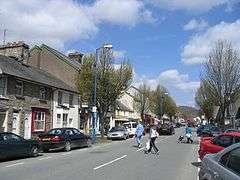 Bala high street | |
 Bala Location within Gwynedd | |
| Population | 1,974 (2011) |
| OS grid reference | SH925359 |
| • Cardiff | 142.3 miles |
| • London | 207 miles |
| Community |
|
| Principal area | |
| Ceremonial county | |
| Country | Wales |
| Sovereign state | United Kingdom |
| Post town | BALA |
| Postcode district | LL23 |
| Dialling code | 01678 |
| Police | North Wales |
| Fire | North Wales |
| Ambulance | Welsh |
| UK Parliament | |
| Senedd Cymru – Welsh Parliament |
|
Bala was ranked as having the 20th highest percentage of Welsh language speakers in Wales by electoral division, in the United Kingdom Census 2011.[3] According to the census, 78.5% of Bala's population can speak Welsh.[4]

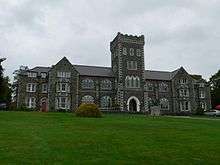
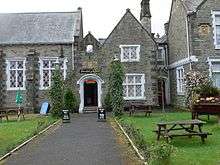
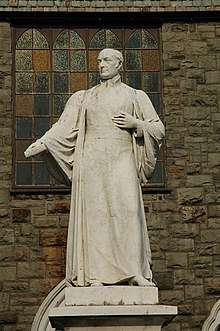
History
The Tower of Bala (Welsh: Tomen y Bala) (30 feet (9 m) high by 50 feet (15 m) diameter) is a tumulus or "moat-hill", formerly thought to mark the site of a Roman camp.
In the 18th century, the town was well known for the manufacture of flannel, stockings, gloves and hosiery.
The large stone-built theological college, Coleg Y Bala, of the Calvinistic Methodists and the grammar school, which was founded in 1712, are the chief features, together with the statue of the Rev. Thomas Charles (1755–1814), the theological writer, to whom was largely due the foundation of the British and Foreign Bible Society.[2]
In 1800 a 15-year-old girl, Mary Jones, walked the 25 miles (40 km) from her home village Llanfihangel-y-Pennant to purchase a Welsh bible in Bala. The scarcity of the Bible, along with the determination of Mary to get one (she had saved for six years), was a major factor in the foundation of the British and Foreign Bible Society in 1804.
Betsi Cadwaladr, who worked with Florence Nightingale in the Crimea, and who gave her name to the Health Board, came from Bala. Other famous people from the Bala area include Michael D. Jones, Christopher Timothy, Owen Morgan Edwards, born in Llanuwchllyn, and T.E. Ellis, born in Cefnddwysarn.
Bala hosted the National Eisteddfod in 1967, 1997 and 2009. The 2009 Eisteddfod was notable because the chair was not awarded to any of the entrants as the standard was deemed to be too low.[5] Bala hosted the Eisteddfod Genedlaethol yr Urdd Gobaith Cymru, National Eisteddfod for the Welsh League of Youth, in 2014. On 16 June 2016, Bala's name was changed to Bale temporarily in honour of Real Madrid forward Gareth Bale. This was only for the duration of UEFA Euro 2016.[6]
Etymology
The Welsh word bala refers to the outflow of a lake.[7]
Twinning
Bala, Ontario, Canada, was named after the town in 1868. They have become twin towns.
Geography
Set within the Bala Fault, Bala Lake (Welsh: Llyn Tegid) is the largest natural lake in Wales at 3.7 miles (6.0 km) in length and 800 m wide. At 35 metres, its depths could hide the tower of St Giles Church in Wrexham and still have 1 metre of water above. The lake has occasionally been known to freeze over, most recently in the severe winters of 1947 and 1963. The rare Gwyniad fish—trapped in the lake at the end of the last Ice Age, some 10,000 years ago—is in danger because its natural home is increasingly unsuitable.[8] A member of the whitefish family, it is found only in Bala Lake.
Cwm Hirnant, a valley running south from Bala, gives its name to the Hirnantian Age in the Ordovician Period of geological time.
The closest major urban areas to Bala are Wrexham at 30 miles (48 km), Chester at 40 miles (64 km), and Liverpool, 52 miles (84 km) to the northeast. Nearby villages include Llanfor, Llandderfel, Llanycil, Llangower, Llanuwchllyn, Rhyd-uchaf and Rhos-y-gwaliau.
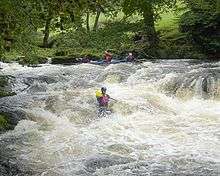
Attractions
The Afon Tryweryn, a river fed from Llyn Celyn which runs through Bala, is world-famous for its white water kayaking. International governing bodies, the International Canoe Federation, the European Canoe Union and the British Canoe Union all hold national and international events there. The Canolfan Tryweryn National Whitewater Centre has its home in Bala. There are at least three local campsites that cater for the influx of canoeists from many parts of the world.
An annual music festival known as 'Wa Bala' is also held in the town. The venue hosts local Welsh bands and is similar in format to Dolgellau's Sesiwn Fawr.
Nearby are the mountains Aran Fawddwy and Arenig Fawr.
Coleg y Bala is at the top of the hill on the road towards Llyn Celyn. The Victoria Hall is a small old cinema, that had been a community hall. There are several chapels: notably Capel Mawr and Capel Bach. The livestock market on Arenig Street is still going strong. Bro Eryl estate was built just after World War II. Mary Jones World, a heritage centre about Mary Jones and her Bible is located just outside the town in nearby Llanycil.
Transport
| Railway stations in Bala | ||||||||||||||||||||||||||||||||||||||||||||||||||
|---|---|---|---|---|---|---|---|---|---|---|---|---|---|---|---|---|---|---|---|---|---|---|---|---|---|---|---|---|---|---|---|---|---|---|---|---|---|---|---|---|---|---|---|---|---|---|---|---|---|---|
| ||||||||||||||||||||||||||||||||||||||||||||||||||
Bala has been served by various railway stations on the Great Western Railway:[9]
- Bala Lake Halt railway station was Bala's first station, on the Bala and Dolgelly Railway (open 1868 to 1882; 1934 to 1939)
- Bala (Penybont) railway station is the name of the Bala Lake heritage railway's station on the site of the Bala Lake Halt
- Bala (New) railway station - Bala's second station, on the Festiniog and Blaenau Railway (open 1882 to 1965)
- Bala Junction railway station - The meeting point of the Bala and Dolgellau Railway, Corwen and Bala Railway and the Bala and Festiniog Railway (open 1882 to 1965)
The Bala Lake Railway (Welsh: Rheilffordd Llyn Tegid) runs for 4.5 miles (7.2 km) from Llanuwchllyn to the edge of the town, along a section of the former trackbed of the Great Western Railway's line between Ruabon and Barmouth. It terminates at Bala (Penybont) railway station, which opened in 1976 on the site of the former Lake Halt station. As of 2020, work is being undertaken to extend the line along the lake foreshore to a new station in the town center.[10]
Bus services are provided by Lloyds Coaches, as part of the Welsh Government funded TrawsCymru network. Services operate westbound to Barmouth via Dolgellau, and eastbound to Wrexham via Corwen and Llangollen. Through ticketing is available for onward connections at Dolgellau, to Bangor, Machynlleth and Aberystwyth.
The town lies on the A494, a major trunk road that leads to Dolgellau, 18 miles to the southwest, and to Ruthin, Mold and Queensferry to the northwest. The A4212 starts in the town, and crosses the Migneint to Trawsfynydd. Heading southeast, the B4391 crosses the Berwyn range to the English border and the town of Oswestry.
Sport
Bala is home to Welsh Premier League football club Bala Town F.C. who play at Maes Tegid. Bala's local rugby club is Bala RFC.
Notable people
- T. E. Ellis politician and leader of Cymru Fydd
- Michael D. Jones, a Welsh Congregationalist minister, principal of Bala theological college, a founder of the Welsh settlement in Patagonia and one of the fathers of modern Welsh nationalism, was born in Llanuwchlyn.
- Christopher Timothy, actor, born in Bala.
Climate
As with the rest of the UK, Bala benefits from a maritime climate, with limited seasonal temperature ranges, and generally moderate rainfall throughout the year. There is a met office weather station at Bala, sited at 1358 ft above sea level.
| Climate data for Bala 163 m, 1971–2000 | |||||||||||||
|---|---|---|---|---|---|---|---|---|---|---|---|---|---|
| Month | Jan | Feb | Mar | Apr | May | Jun | Jul | Aug | Sep | Oct | Nov | Dec | Year |
| Average high °C (°F) | 6.7 (44.1) |
6.8 (44.2) |
8.7 (47.7) |
11.1 (52.0) |
14.6 (58.3) |
16.8 (62.2) |
19.1 (66.4) |
18.8 (65.8) |
16.2 (61.2) |
12.9 (55.2) |
9.4 (48.9) |
7.5 (45.5) |
12.4 (54.3) |
| Average low °C (°F) | 0.9 (33.6) |
0.8 (33.4) |
2.1 (35.8) |
2.8 (37.0) |
5.2 (41.4) |
8.0 (46.4) |
10.2 (50.4) |
9.8 (49.6) |
8.0 (46.4) |
5.6 (42.1) |
3.0 (37.4) |
1.6 (34.9) |
4.8 (40.7) |
| Source: YR.NO[11] | |||||||||||||
Gallery
- Christ Church
- Christ Church
See also
- Bala Series of geologic beds in Bala
- Bala Cynwyd, Pennsylvania
- Bala Town F.C., local football team.
- Bala RFC, local rugby union club.
References
- "Area: Bala. Key Figures for People and Society: Population and Migration". ONS. ONS. Archived from the original on 4 April 2017. Retrieved 4 April 2017.
-

- "Welsh speakers by electoral division, 2011 Census". Stats Wales. Stats Wales. Archived from the original on 9 February 2018. Retrieved 10 April 2017.
- "Area: Bala. Welsh Language Profile, 2011 (KS208WA)". ONS. ONS. Archived from the original on 4 April 2017. Retrieved 4 April 2017.
- "No-one worthy of eisteddfod chair". BBC News. 7 August 2009. Retrieved 13 March 2011.
- https://www.theguardian.com/football/2016/jun/16/bala-changes-name-gareth-bale-euro-2016
- Geiriadur Prifysgol Cymru. a–baldog. University of Wales. 2006. p. 648. Archived from the original on 28 December 2005. Retrieved 27 September 2012.
- Freyhof, J. & Kottelat, M. 2008. Coregonus pennantii. In: IUCN Red List of Threatened Species. Version 2010.1. Downloaded on 17 April 2010.
- Butt, R. V. J. (1995). The Directory of Railway Stations: details every public and private passenger station, halt, platform and stopping place, past and present (1st ed.). Sparkford: Patrick Stephens Ltd. ISBN 978-1-85260-508-7. OCLC 60251199.
Jowett, Alan (March 1989). Jowett's Railway Atlas of Great Britain and Ireland: From Pre-Grouping to the Present Day (1st ed.). Sparkford: Patrick Stephens Ltd. ISBN 978-1-85260-086-0. OCLC 22311137.
Jowett, Alan (2000). Jowett's Nationalised Railway Atlas (1st ed.). Penryn, Cornwall: Atlantic Transport Publishers. ISBN 978-0-906899-99-1. OCLC 228266687. -
- //www.balalakerailwaytrust.org.uk/ Downloaded on 16 April 2020.
- "Climate Normals 1971–2000". YR.NO. Retrieved 3 March 2011.
External links
| Wikimedia Commons has media related to Bala, Gwynedd. |
| Wikivoyage has a travel guide for Bala. |
